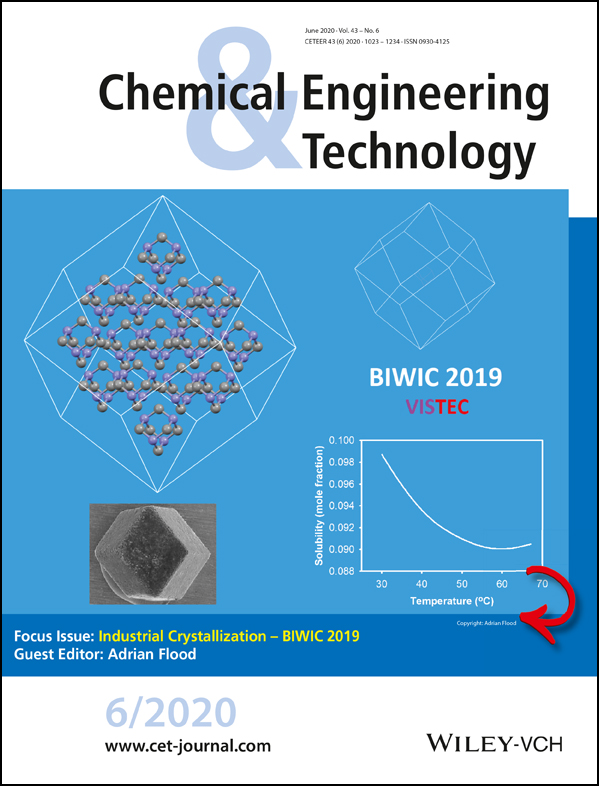Effect of Anti-Encrustation Additives on Zirconium Molybdate Hydrate
Corresponding Author
Risako Abe
Waseda University, Department of Applied Chemistry, School of Advanced Science and Engineering, 3-4-1 Okubo, Shinjuku, 169-8555 Tokyo, Japan
Correspondence: Risako Abe ([email protected]), Waseda University, Department of Applied Chemistry, School of Advanced Science and Engineering, 3-4-1 Okubo, Shinjuku, 169-8555 Tokyo, Japan.Search for more papers by this authorIzumi Hirasawa
Waseda University, Department of Applied Chemistry, School of Advanced Science and Engineering, 3-4-1 Okubo, Shinjuku, 169-8555 Tokyo, Japan
Search for more papers by this authorYasunori Miyazaki
Japan Atomic Energy Agency, Tokai-mura, Naka-gun, 319-1194 Ibaraki, Japan
Search for more papers by this authorMasayuki Takeuchi
Japan Atomic Energy Agency, Tokai-mura, Naka-gun, 319-1194 Ibaraki, Japan
Search for more papers by this authorCorresponding Author
Risako Abe
Waseda University, Department of Applied Chemistry, School of Advanced Science and Engineering, 3-4-1 Okubo, Shinjuku, 169-8555 Tokyo, Japan
Correspondence: Risako Abe ([email protected]), Waseda University, Department of Applied Chemistry, School of Advanced Science and Engineering, 3-4-1 Okubo, Shinjuku, 169-8555 Tokyo, Japan.Search for more papers by this authorIzumi Hirasawa
Waseda University, Department of Applied Chemistry, School of Advanced Science and Engineering, 3-4-1 Okubo, Shinjuku, 169-8555 Tokyo, Japan
Search for more papers by this authorYasunori Miyazaki
Japan Atomic Energy Agency, Tokai-mura, Naka-gun, 319-1194 Ibaraki, Japan
Search for more papers by this authorMasayuki Takeuchi
Japan Atomic Energy Agency, Tokai-mura, Naka-gun, 319-1194 Ibaraki, Japan
Search for more papers by this authorAbstract
Anti-encrustation additives were mainly investigated in nitric acid solution with zirconium (Zr), molybdenum (Mo), and tellurium (Te) to prevent the encrustation of zirconium molybdate hydrate (ZMH). The ZMH generated by reaction crystallization of Mo and Zr as main fission products has a high adhesion property in spent nuclear fuel reprocessing. In addition, it is reported that Te, which is also one of the fission products, precipitates together with ZMH. Encrustation of precipitates containing Te was effectively prevented by adding molybdenum trioxide (MoO3) crystals as an anti-encrustation reagent. The encrustation amount was found to be larger than that under the condition of only Zr and Mo without Te. Consequently, it was suggested that the high adhesion property of Te affected the encrustation amount of ZMH.
References
- 1
Z. Amjad, in Mineral Scale Formation and Inhibition (Eds: L. A. Perez, D. F. Zidovec), Springer, New York
1995, 47–61. DOI: https://doi.org/10.1007/978-1-4899-1400-2
10.1007/978-1-4899-1400-2_5 Google Scholar
- 2 A. L. Kavitha, T. Vasudevan, H. Gurumallesh Prabu, Desalination 2011, 268 (1–3), 38–45. DOI: https://doi.org/10.1016/j.desal.2010.09.047
- 3 Y. M. Al-Roomi, K. F. Hussain, Desalination 2015, 355, 38–45. DOI: https://doi.org/10.1016/j.desal.2014.10.010
- 4 Y. M. Al-Roomi, K. F. Hussain, M. Al-Rifaie, Desalination 2015, 375, 138–148. DOI: https://doi.org/10.1016/j.desal.2015.07.028
- 5 M. Nakahara, T. Koizumi, K. Nomura, Nucl. Technol. 2011, 173 (2), 183–190. DOI: https://doi.org/10.13182/NT11-A11547
- 6 S. Imoto, J. Nucl. Mater. 1986, 140 (1), 19–27. DOI: https://doi.org/10.1016/0022-3115(86)90192-3
- 7 M. Takeuchi, K. Yano, A. Shibata, Y. Sanbonmatsu, K. Nakamura, T. Chikazawa, I. Hirasawa, J. Nucl. Sci. Technol. 2015, 53 (4), 521–528. DOI: https://doi.org/10.1080/00223131.2015.1060907
- 8 W. Li, W. Duan, T. Sun, C. Liu, J. Wang, J. Chen, J. Radioanal. Nucl. Chem. 2017, 314 (1), 221–229. DOI: https://doi.org/10.1007/s10967-017-5357-0
- 9 T. Izumida, F. Kawamura, J. Nucl. Sci. Technol. 1990, 27 (3), 267–274. DOI: https://doi.org/10.1080/18811248.1990.9731179
- 10 B. S. M. Rao, E. Gantner, J. Reinhardt, D. Steinert, H. J. Ache, J. Nucl. Mater. 1990, 170 (1), 39–49. DOI: https://doi.org/10.1016/0022-3115(90)90324-G
- 11 S. Jakab-Costenoble, I. Rumaux, E. Odore, S. Picart, J. Nucl. Sci. Technol. 2018, 55 (11), 1235–1244. DOI: https://doi.org/10.1080/00223131.2018.1492468
- 12 K. Shirahashi, M. Kubota, J. Nucl. Sci. Technol. 2012, 29 (6), 559–565. DOI: https://doi.org/10.1080/18811248.1992.9731564
- 13 Y. Kondo, M. Kubota, J. Nucl. Sci. Technol. 1992, 29 (2), 140–148. DOI: https://doi.org/10.1080/18811248.1992.9731506
- 14 M. Kubota, T. Fukase, J. Nucl. Sci. Technol. 1980, 17 (10), 783–790. DOI: https://doi.org/10.1080/18811248.1980.973265
- 15 Y. Kondo, J. Radioanal. Nucl. Chem. 1995, 191 (1), 115–128. DOI: https://doi.org/10.1007/BF02035991
- 16 Y. Kondo, M. Matsumura, M. Kubota, J. Radioanal. Nucl. Chem. 1994, 177 (2), 301–309. DOI: https://doi.org/10.1007/BF02061126
- 17 Y. Kondo, M. Kubota, J. Radioanal. Nucl. Chem. 1997, 221 (1–2), 45–52. DOI: https://doi.org/10.1007/BF02035241
- 18 B. S. M. Rao, E. Gantner, H. G. Muller, J. Reinhardt, D. Steinert, H. J. Ache, Appl. Spectrosc. 1986, 40 (3), 330–336. DOI: https://doi.org/10.1366/0003702864509169
- 19 Y. Kondo, M. Matsumura, M. Kubota, J. Radioanal. Nucl. Chem. 1994, 177 (2), 311–320. DOI: https://doi.org/10.1007/BF02061127
- 20 T. Arai, D. Ito, I. Hirasawa, Y. Miyazaki, M. Takeuchi, Chem. Eng. Technol. 2018, 41 (6), 1199–1204. DOI: https://doi.org/10.1002/ceat.201700663
- 21 A. Clearfield, R. H. Blessing, J. Inorg. Nucl. Chem. 1972, 34 (8), 2643–2663. DOI: https://doi.org/10.1016/0022-1902(72)80213-6
- 22 L. Seguin, M. Figlarz, R. Cavagnat, J.-C. Lassègues, Spectrochim. Acta, Part A 1995, 51 (8), 1323–1344. DOI: https://doi.org/10.1016/0584-8539(94)00247-9
- 23
R. Murugan, A. Ghule, C. Bhongale, H. Chang, J. Mater. Chem.
2000, 10 (9), 215–2162. DOI: https://doi.org/10.1039/b000811g
10.1039/b000811g Google Scholar
- 24 A. Sasahira, T. Hoshikawa, T. Nakamura, T. Fukasawa, F. Kawamura, J. Nucl. Sci. Technol. 1994, 31 (4), 321–328. DOI: https://doi.org/10.3327/jnst.31.321
- 25 A. Sasahira, F. Kawamura, J. Nucl. Sci. Technol. 1988, 25 (7), 603–606. DOI: https://doi.org/10.1080/18811248.1988.9735899
- 26 F. J. Doucet, D. T. Goddard, C. M. Taylor, I. S. Denniss, S. M. Hutchison, N. D. Bryan, Phys. Chem. Chem. Phys. 2002, 4 (14), 3491–3499. DOI: https://doi.org/10.1039/b201792j
- 27 A. Magnaldo, M. Masson, R. Champion, Chem. Eng. Sci. 2007, 62 (3), 766–774. DOI: https://doi.org/10.1016/j.ces.2006.08.076
- 28 T. Usami, T. Tsukada, T. Inoue, N. Moriya, T. Hamada, D. Serrano Purroy, R. Malmbeck, J.-P. Glatz, J. Nucl. Mater. 2010, 402 (2–3), 130–135. DOI: https://doi.org/10.1016/j.jnucmat.2010.05.008
- 29 L. Zhang, M. Takeuchi, T. Koizumi, I. Hirasawa, Front. Chem. Sci. Eng. 2013, 7 (1), 65–71. DOI: https://doi.org/10.1007/s11705-013-1314-9
- 30 E. Esbelin, P. Gareil, M. Masson, J.-L. Emin, Anal. Chim. Acta. 2001, 442 (1), 171–182. DOI: https://doi.org/10.1016/S0003-2670(01)01088-1




